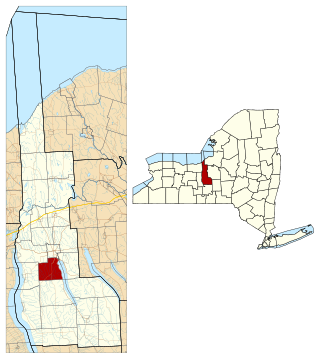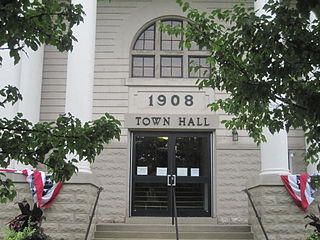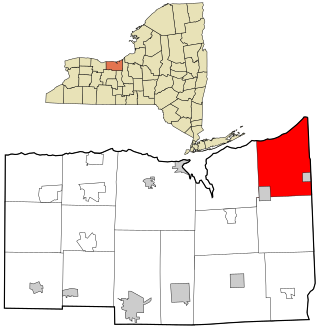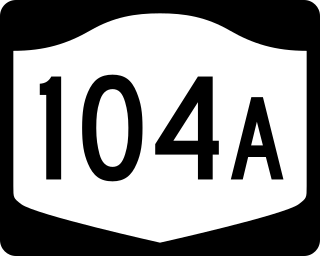
Wayne County is a county in the U.S. state of New York. As of the 2020 Census, the population was 91,283. The county seat is Lyons. The name honors General Anthony Wayne, an American Revolutionary War hero and American statesman. The county is part of the Finger Lakes region of the state.

Aurelius is a town in Cayuga County, New York, United States. The population was 2,610 at the 2020 census. The town was named after the Roman emperor Marcus Aurelius. It is at the western edge of the county and borders the city of Auburn.
Fair Haven is a village located on the southern shore of Lake Ontario in Cayuga County, New York, United States. As of the 2020 census, its population was 760. Fair Haven is within the town of Sterling and is northwest of Syracuse. The village is on Little Sodus Bay, an arm of Lake Ontario.

Fleming is a town in Cayuga County, New York, United States. The population was 2,475 at the 2020 census. The name is that of General George Fleming, an early settler. Fleming is at the northern end of Owasco Lake, south of Auburn.

Sempronius is a town in Cayuga County, New York, United States. The population was 895 at the 2010 census. The town was named after a Roman military and political leader by Robert Harpur, a clerk interested in the classics. Sempronius is in the southeastern part of the county, southeast of Auburn.

Springport is a town in Cayuga County, New York, United States. The population was 2,367 at the 2010 census. The name is derived from the local springs and lakeports. Springport is on the western border of the county and is southwest of Auburn.

Summerhill is a town in Cayuga County, New York, United States. The population was 1,217 at the 2010 census. The town name is that of a location in Ireland. Summerhill is in the southeastern corner of the county and is northeast of Ithaca.

Victory is a town in Cayuga County, New York, United States. The population was 1,660 at the 2010 census. The name celebrates the political victory in forming the town. It is in the northwestern part of the county and north of Auburn.
Romulus is a town in Seneca County, New York, United States. The population was 3,203 at the 2020 census. The town is named after the mythical founder of Rome, Romulus, a name assigned by a clerk with an interest in the classics. It is located in the central part of the county, northwest of Ithaca, New York.
Varick is a town in Seneca County, New York, United States. The population was 1,656 at the 2020 census. The town is named after Richard Varick, an officer in the American Revolution, mayor of New York City, and uncle of the first Town Supervisor, Anthony Dey.
Troupsburg is a town in Steuben County, New York, United States. The population was 1,016 at the 2020 census. The town is named after Robert Troup, an agent of the Pulteney Estate.
Danby is a town in Tompkins County, New York, United States. The population was 3,457 at the 2020 census. The town is in the southern part of the county and is south of the city of Ithaca.

Huron is a town in Wayne County, New York, United States. The population was 2,118 at the 2010 census. The town is named after the Huron Indians.

Williamson is a town on the south shore of Lake Ontario in the northwest part of Wayne County, New York, United States. The population was 6,984 at the time of the 2010 census. The town is named after Charles Williamson, a land agent of the Pulteney Estate. Its primary ZIP code is 14589, and telephone exchanges 589 and 904 in area code 315.

Plattsburgh is a town in Clinton County, New York, United States. The population was 11,886 at the 2020 census. The town is named after Zephaniah Platt, an early land owner, and it surrounds the separate and more populous city of the same name. The town is in the eastern part of the county, in the North Country region of the state of New York. The region's airport, Plattsburgh International Airport, is located in the southern part of the town.

Homer is a town in Cortland County, New York, United States of America. The population was 6,405 at the 2010 census. The name is from the Greek poet Homer.

Oswego is a town in Oswego County, in the U.S. state of New York. The population was 7,984 at the 2010 census.

Sodus is a town in Wayne County, New York, United States. The population was 8,384 at the 2010 census. The town takes its name from a native word for the bay in the eastern part of the town: "Assorodus," meaning "silvery water."

Wolcott is a town in the north-eastern corner of Wayne County, New York, United States. The population of the town was 4,453 at the 2010 census. The town is named after Governor Oliver Wolcott of Connecticut.

New York State Route 104A (NY 104A) is a northeast–southwest state highway in the central portion of New York in the United States. It serves as a northerly alternate route of NY 104, to which it connects at each end. The route extends for 17.38 miles (27.97 km) from an intersection with NY 104 and NY 370 south of the village of Red Creek in Wayne County to a junction with NY 104 southwest of the city of Oswego. NY 104A spans three counties, serves two villages and parallels Lake Ontario for much of its length. All of NY 104A is part of the Seaway Trail, a National Scenic Byway.


















